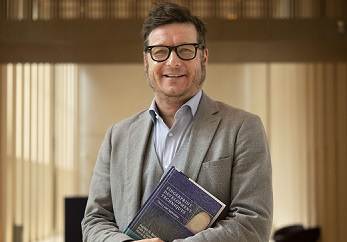‘Fingerprints don’t lie’
Can a fingerprint provide stronger evidence in court? ‘Absolutely,’ says Marcel de Puit. ‘Important innovations are happening in the field of forensic fingerprint analysis.’

Marcel de Puit (44) is a chemist and fingerprint expert at the Netherlands Forensic Institute (NFI). In 2015 Wiley publishers asked him to write a review of Stephen Bleay’s book proposal. The author found the review so valuable that he asked Mr De Puit to co-author the book. Now, three years later, their book Fingerprint Development Techniques is complete and will be available in bookstores in May.
Who was the book written for?
‘Of course the book will interest people who work with fingerprints, but students and forensic analysts will also find it a valuable reference work. We look back at the history of fingerprinting and we examine the science, describing new technologies and insights that we combine with knowledge from other disciplines, like materials science. For instance, why is it possible to use a particular kind of powder on a piece of wood but not on a window? And besides the familiar lines that we use to match fingerprints, what other information can we draw from a fingerprint?’
What else can a fingerprint tell us?
‘You can’t see anything with the naked eye, but a lot of information can be distilled from a fingerprint. A typical fingerprint as we know it in the traditional sense provides only a small amount of information about someone. Thanks to new technologies and applications, today we can identify a whole array of characteristics from the tiniest features. We can examine a person’s recent history by conducting a chemical analysis of a fingerprint and looking for unusual or distinctive information. We can see whether you drank coffee today, but also whether or not you came into contact with narcotics or explosives. If you did, you’ll have some explaining to do.’
How does this work in practice?
‘At the NFI we use a range of methods and take a multidisciplinary approach. This broad analysis enables us to obtain valuable information from fingerprints. Our investigation and processing method is not a restrictive factor. On the contrary. We can do a lot and the field is developing rapidly. For example, how much DNA can we extract from a fingerprint and is it the DNA of the person who left the print?’
How proud are you of this book?
‘At the NFI I have my secondary school diploma in a frame hanging on the wall next to my university diploma. I’m equally proud of both. I could never have written this book without my two co-authors. I can’t frame it, but for me this publication is just as important a milestone in my career as a scientist.’
Fingerprint Development Techniques
Stephen M. Bleay, Ruth S. Croxton, Marcel de Puit
Hardcover | 520 pages
€100
ISBN: 978-1-119-99261-5